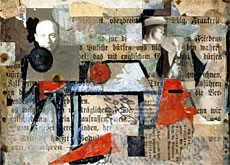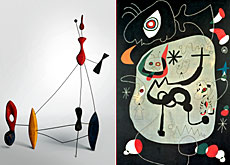Artist gets double exposure in Basel

Twentieth century German avant-garde artist Kurt Schwitters is the subject of two summer exhibitions in Basel.
The Tinguely Museum demonstrates Schwitter’s influence on the next generation of modern artists, while the Kunstmuseum Basel explores his working relationship with fellow artist Hans Arp.
Schwitters, who was born in Hanover in 1887, has been described as one of the artistic pioneers of the first half of the 20th century.
He is famed for his collages and relief constructions made of scrap and waste materials.
Schwitters went on to start his own artistic movement, Merz, taking the name from Kommerz und Privatbank. The movement encompassed painting, sculpture, poetry and text.
Some 150 of the artist’s works are on show at the Tinguely Museum, the largest exhibition of his work in Switzerland since 1971.
Artistic role model
Swiss sculptor and experimental artist Jean Tinguely – to whom the museum is dedicated – regarded Schwitters as an artistic role model.
“I was completely “schwittered”, Schwitters was my hero,” Tinguely (1925-1991) is quoted as saying on first encountering Schwitter’s works.
“Besides [Dadaist-Surrealist artist] Marcel Duchamp, Schwitters was the important artist for Tinguely,” said Annja Müller-Alsbach from the Tinguely Museum.
“He used scrap and methods that were also very important for Tinguely, such as the techniques of assemblage and collage,” she told swissinfo.
The exhibition groups together works – some of which haven’t been exhibited for years – from many private collections and museums such as the Museum of Modern Art in New York.
At the heart of the display is Schwitter’s Merzbau (Merz building), a three-dimensional assemblage dating from 1923. The exhibition houses a walk-in reconstruction of the original, which was destroyed in 1943 and which has been entirely recreated from photographs.
Displays in four more rooms include lithographs, Dadaist watercolours from the twenties, and the journal “Merz” which Schwitters edited and designed.
Another area of the exhibition presents Tinguely’s idea of walk-in structures, which he called “multicultural and multifunctional sculptures of experience” which were strongly influenced by Schwitters.
Life-long friends
Schwitter’s productive and influential friendship with Hans Arp is the subject of the Basel Kunstmuseum’s exhibition, which brings together over 140 of the artists’ works.
In 1918 the Franco-German Arp introduced Schwitters to the new technique of collage, which he had learned in Picasso’s studios.
Arp, a sculptor, painter and poet, was also one of the founding members of the Dada movement – a nihilistic art movement and one of the precursors of surrealism – in Zurich in 1916.
The two artists continued their artistic exchange throughout the 1920s and 1930s. Schwitters incorporated three works by Arp into his “Merzbau” and Arp acquired several works by Schwitters, among them “Springtime Picture” which is on show at the museum.
“They are two very important, very influential artists and artists who marked their century, who opened a new dimension to art,” event curator Hartwig Fischer told swissinfo.
“We show them together because they were close friends, they worked together, they remained in touch for most of their lives and they furthered their development mutually – and this relationship between the two artists has never been shown in an exhibition,” said Fischer.
Many of the works – some of them on display for the first time – are on loan from private collections and museums such as the Centre Pompidou in Paris and London’s Tate Modern.
Swiss link
Fischer says that the artists had strong links to Basel and to Switzerland.
Arp frequently returned to the country after he set up his studio in Paris in 1925 and maintained a studio in Basel. Both artists were championed by Swiss collectors.
Apart from the Swiss connection, Fischer says both artists have many other qualities in common.
“They are extremely witty, funny artists and they are whimsical artists,” said Fischer.
“And this show has a light touch, there’s no heavy erudition to it. We really tried to bring out the lightness that characterises these two artists.”
swissinfo, Isobel Leybold in Basel
Kurt Schwitters (1887-1948) and Hans Arp – also known as Jean Arp – (1886-1966) were lifelong friends and leading lights of the European avant-garde.
Tinguely Museum, Kurt Schwitters. Merz – a total vision of the world: ends August 22, 2004.
Kunstmuseum Basel, Schwitters Arp: August 22, 2004
The two exhibitions are being shown at the same time as, and in coordination with, the Calder-Miró exhibition at the Beyeler Foundation (ends September 5 2004).

In compliance with the JTI standards
More: SWI swissinfo.ch certified by the Journalism Trust Initiative


You can find an overview of ongoing debates with our journalists here. Please join us!
If you want to start a conversation about a topic raised in this article or want to report factual errors, email us at english@swissinfo.ch.